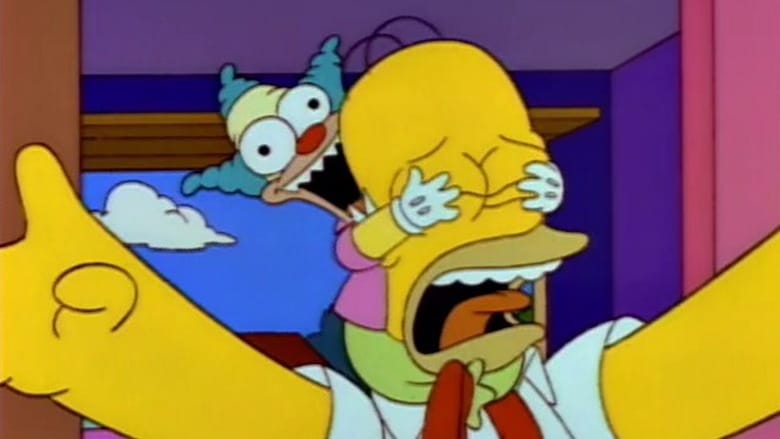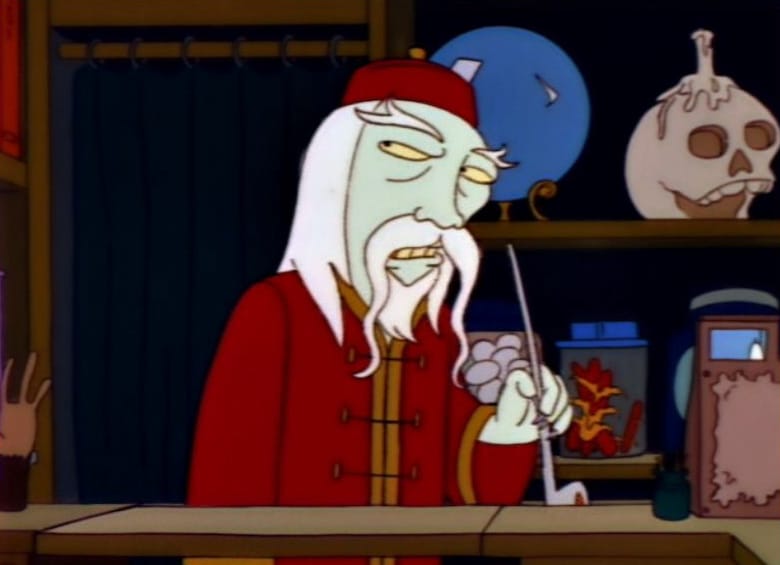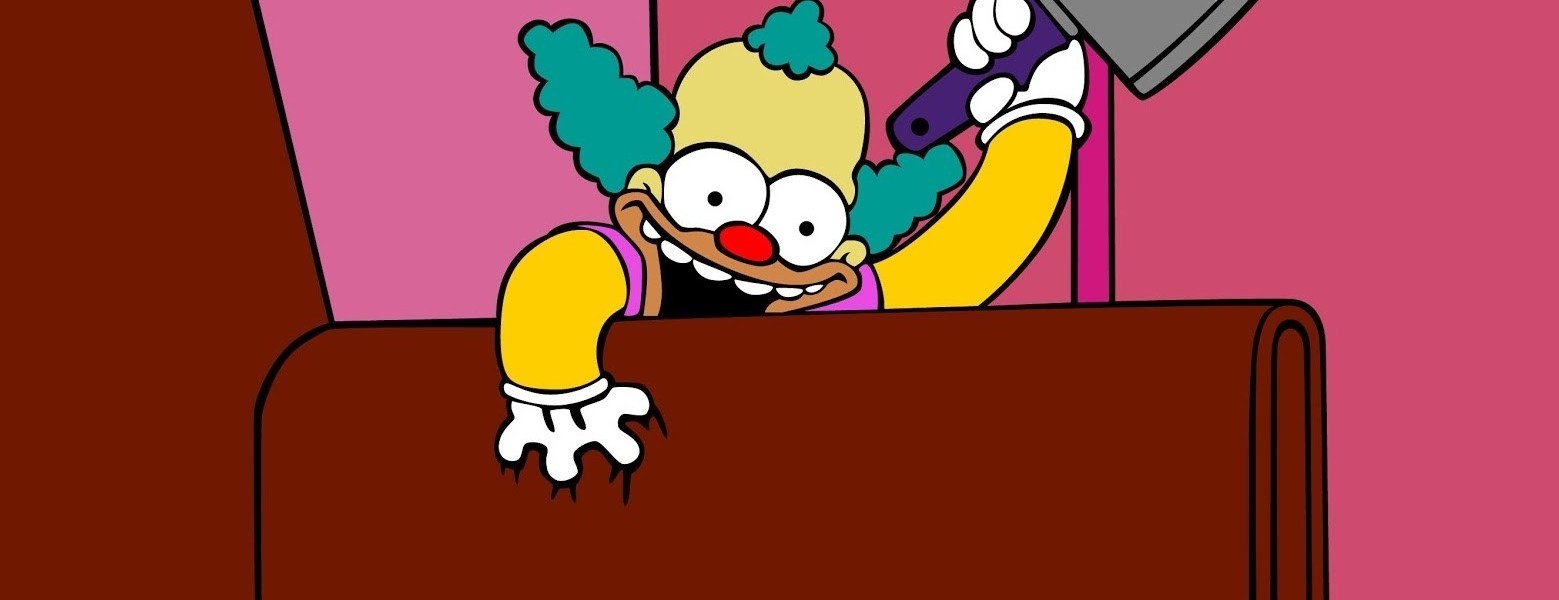What could be scarier than an evil Krusty doll? That’s the question that the third installment of the Treehouse of Horror series asks us. It’s part of the brilliant fourth season of the show, one that is frequently ranked as the absolute best in the show’s history. “Clown Without Pity” is the segment featuring the Chucky – er, Krusty – doll. It deftly parodies some very familiar horror tropes while showing the writers at the tops of their games comedy-wise.
At the end of the day, a doll isn’t all that scary. (To be honest, the real Krusty the Clown might be scarier to me than an evil Krusty doll.) But the Simpsons knows that scary movies are made scary through the pacing. With enough tension, a doll can be horrifying. That was what was played on in this segment. Let’s take a look at which horror tropes they dismantled with this one.
Summary of “Clown Without Pity”
The segment opens in an unassuming way. Bart is celebrating his birthday, and the family is gathered together to celebrate. Grandpa Simpson gifts Bart a massive box of cash (which he received from “the government,” he says), and Bart then turns to Homer for his next gift. If you’ve seen one episode of the Simpsons before, you can probably guess what Homer got Bart: nothing.
Homer runs off to buy a last minute gift, and he stumbles upon a nice little hole-in-the-wall shop aptly titled the House of Evil. Sounds like a pleasant enough place, right? He goes inside, and the vendor shows off his distinctly evil wares: a shrunken head, a still-beating heart, frozen yogurt, et cetera. The vendor then picks up a doll of Krusty the Clown, warns of a curse, and hands it over to Homer.
Homer brings the doll home, gives it to Bart, and things seem great. But it’s not too long until the evil Krusty doll decides to start his reign of terror.

He has it out for Homer in particular, and relentlessly tries to kill him. Marge eventually decides to call the company who made the doll, and they send someone over. He fixes it, the evil Krusty doll becomes Homer’s personal servant, and everything ends well. Even the little Krusty has a happy ending by finding love with Lisa’s Malibu Stacy.
Trope 1 – All’s Well That Starts Well
We all know that you can’t just start a horror movie with the scariest scene. You need to slowly build up the tension to keep the audience interested. There are the obvious exceptions (the opening of The Conjuring infamously kept many viewers on the edges of their seats), but most great horror films start in a relatively idyllic setting. It’s not like they’re swimming in the pool of skeletons when Poltergeist first starts. No, they’re just living in a peaceful community. That community happens to be built on a burial ground, sure, but we don’t learn that until near the end of the movie.
“Clown Without Pity” starts off the same way. Rather than just immediately introducing us to the evil Krusty doll, it humorously begins in a setting that is honestly more cheerful than we see in other Simpsons episodes. Bart receiving an enormous pile of money from Grandpa isn’t a normal plot point that we should be accustomed to. It’s used here to contrast the beginning of the segment with the terror that is to come later. Is it exaggerated? Yes, of course… but that’s the point.
It should also be noted that the way this segment transitions from happiness to horror is also intentionally abrupt. A great horror film will gradually let the dread creep in, but countless other B-movies see the characters go from living perfect lives to literally fighting against death in mere seconds. Homer just happens to drive up to the most evil-sounding shop of all time (the House of Evil, that is) just after Bart’s birthday party. It’s funny to think that this kind of dramatic shift in tone isn’t all that uncommon in poorly-written horror.
Trope 2 – The Mystical Salesman
Before we get to the evil Krusty doll, it’s important that we analyze one other minor character in this segment: the shopkeeper from the House of Evil. This guy is just dripping in intentional stereotypes, as he is pretty much a direct parody of Mr. Wing, the shopkeeper from Gremlins.
The troubling trope at play here is the mystical Eastern salesman. Horror movies (and indeed all of cinema) are full of examples of characters like this. It’s an easy way to introduce some type of “otherworldly” object into a film. As Jagarippy on Reddit succinctly put it, “If you want to represent ancient wisdom in the 80s, you hired an old Chinese dude.” Of course, it’s not just wisdom that this archetype represents, but a type of primeval knowledge that is forbidden, obscure, and even scary. Basically, if a vaguely Eastern-looking person is selling something, audiences are supposed to assume that it is both strange and, of course, evil.

And so the evil Krusty doll is introduced into “Clown Without Pity.” But, in typical Simpsons’ fashion, they have to deconstruct the trope just a bit. Rather than just having him be the straightforward version of this character that we’re used to, the shopkeeper from the House of Evil also sells frozen yogurt. In fact, the evil Krusty doll was being sold as a two-for-one alongside some frogurt.
Homer’s fluctuations between, “That’s bad,” and “That’s good!” as the shopkeeper tells him about the deal feel just pitch perfect here. “Clown Without Pity” is toying around with pacing in horror throughout, and this is no different. The mystical salesman character is often morally ambiguous, and Homer’s exclamations just mirror how an audience typically reacts to characters like Mr. Wing. Is he good, or is he bad? It all depends on whether he puts poison in the frogurt or not. So to speak.
Trope 3 – The Evil Doll
There are plenty of subtle parodies going on in this segment, but the obvious center of the story revolves around the evil Krusty doll. This is quite clearly going off of the evil doll trope that we should all be familiar with. Whether it’s Annabelle or Chucky or anything in between, any fan of horror instinctually gets a little tense when a doll is on the screen.
But the evil Krusty doll completely takes this trope apart. It’s like the writers used the Riddikulus spell from Harry Potter to show just how silly it is to be scared of a doll. His first attack on Homer begins creepily enough, but he then has to ask Homer to pull the string on his back so he can continue laughing menacingly at him. Suddenly we’re laughing rather than turning away in fear.
— FOUNDATIONS OF HORROR —
Further explore these subgenres & tropes. more>>
#Scary Clowns are Scary | #Comedy horror

This trend of tension diffusing continues on through the rest of the evil Krusty doll segment. Every moment that would normally be scary is immediately offset with a joke that lightens the mood. The evil Krusty doll chases Homer out of the bath with a little harpoon, and Homer dashes out of the tub fully naked. When Patty sees him, she remarks that the last shreds of her heterosexuality have gone. Ha! Homer then puts the doll in a bag of dirty socks to keep it at bay, and it actually works thanks to the deadly fumes in the bag.
The ending of the segment is the true coup de grace however. When the repairman finally comes around to fix the doll, he immediately notices the problem: the doll was set to evil rather than good. A simple flip of the switch was all it needed. If only the Warrens had thought of that!
Like all other Treehouse of Horror segments, this one does a great job of making us laugh at things that would normally make us feel uneasy. Horror is freaky, yes, but it’s also funny. A living, breathing, knife-wielding doll is scary, but only if the filmmakers make us scared of it. In a way, a masterful piece of horror forces us to flip the doll’s switch between evil and good in our minds. If no one gives us a compelling reason to believe that Chucky (or Krusty) is evil, we are just going to laugh at him.
Last Updated on August 1, 2021.

